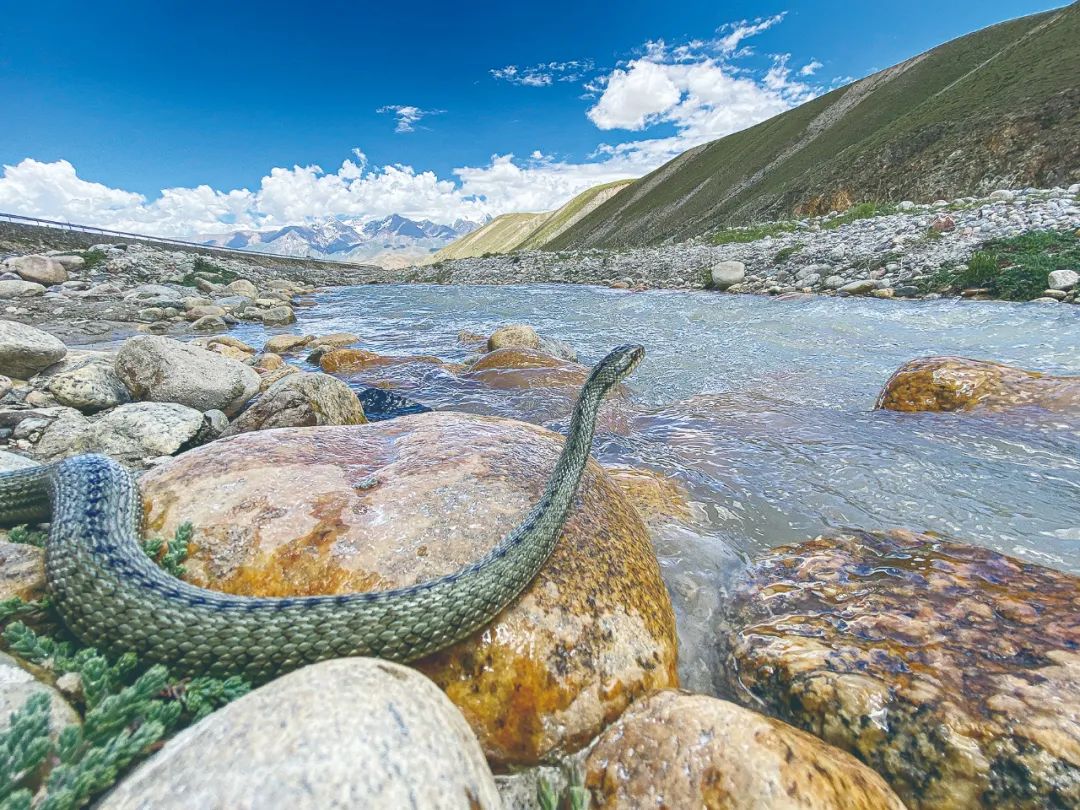The highest "alternative": How does a snake live in the Qinghai -Tibet Plateau?
Author:Journal of China Science Time:2022.08.29
Text | "China Science News" reporter Hu Yanqi
Snake is an important representative temperature -changing vertebrate. Due to the low level of metabolism, it cannot produce sufficient calories to maintain constant body temperature. Generally, it is necessary to use the external temperature to increase body temperature.
There is a special snake in my country that can adapt to the high -cold Qinghai -Tibet Plateau, and settled on the plateau surface of 3700 to 4,850 meters above sea level, becoming one of the highest -level snakes in the world.
The reason why they become the "alternative" of the family is because they have a very special survival strategy, and they are alive by "bubble" hot springs.
Researchers at the Chengdu Institute of Biology of the Chinese Academy of Sciences revealed the mystery of this special species -the hot spring of Tibetan hot spring snakes. Related results have been published recently in "Innovation".

Tibetan hot spring snake. Photo by Guo Junfeng
The only snake that uses geothermal resources to survive
Scientists have discovered three kinds of hot spring snakes in our country, namely Tibetan hot spring snakes, Sichuan hot spring snakes and Shangri -La hot spring snakes. They are unique species of the Qinghai -Tibet Plateau, the only snake to survive with geothermal resources.
Among them, the Tibetan hot spring snake is a unique species in Tibet.
The category of hot spring snakes was gradually differentiated in about 28 million years ago. At that time, the Qinghai -Tibet Plateau was in a relatively early period.
Today, the Tibetan hot spring snake is mainly distributed in areas with rich geothermal resources in the middle and lower reaches of the Yarlung Tibetan River, including Lhasa, Shannan, Shigatse, Nyingchi and other places.
"Hot spring snakes belong to the family food snails, and their close types are currently only distributed in the United States, and they are mainly in tropical America. Their living environment is very different." Li Jialang, a researcher at the Chengdu Institute of Biology, Chinese Academy of Sciences.
However, the reason why the Tibetan hot spring snake can live in the cold Qinghai -Tibet Plateau is not because they are really "freezing", but because they have the ability to find heat sources.
The formation of the Qinghai -Tibet Plateau is derived from the collision of the Indian sector and the Eurasia. While this severe surface movement is formed, it also brings countless geothermal resources to the plateau, such as hot springs.
Yangbajing, Yangyi, Naqu Town and other places in Lhasa City in Tibet have rich hot spring resources.
Hot spring brings the heat from the ground directly to the surface, so the surface and soil temperature near the hot spring are higher than other places.
"Actually, the Tibetan hot spring snake will not really be soaked in the hot spring for a long time, but uses geothermal geothermal around the hot spring to enhance its body temperature and resist the cold." Stone piles, meadows, etc. are suitable for them to survive.
Sometimes, after improving their body temperature, they will enter the cold water such as streams, rivers or static ponds near the hot springs to prey on alpine frogs, plateau loach, and different teeth.
Mutation of Star Gene TRPA1
In the long history of evolution, how does Tibetan hot spring snake successfully adapt to this unique natural environment? In order to answer this question, the Lijiadang team conducted detailed multi -dimensional integration research on the hot spring snake in Yangbajing area in Tibet.
They first performed an experiment of fever. It was found that compared with the corn snake and Mengla blunt head, the Tibetan hot spring snake could locate the high temperature area faster and showed a strong preference for high temperature areas.
Therefore, researchers believe that the Tibetan hot spring snake has an efficient temperature perception system, thereby enhancing their ability to detect the warm environment under cold stimulation.
Scientists have found molecular biological evidence behind this ability.
Researchers have evolved and changed the genetic analysis of the genome of the Tibetan hot spring snake through comparative genomics analysis, including the evolutionary changes related to the temperature related to the temperature, including multiple instantaneous receptor potential (TRP) ion channels related to temperature.
For example, TRPV3 related to temperature has experienced rapid evolution, and TRPM8 related to cold sensation shows the rapid evolution of sharing with other plateau species.
"The most important thing is that we found that the star gene -TRPA1 has a unique mutation in the Tibetan hot spring snake." Li Jialang introduced.
In 2021, the Nobel Prize winner David Julius's research on TRPV1 and his family opened a human exploration of human perception mechanisms.
TRPA1 is an instantaneous receptor potential ion channel, which is related to temperature perception, pain, itching and other.
Among the reptiles, TRPA1 will participate in the heat detection of some snakes, including infrared detection behavior.
Li Jiazang explained that among infrared snakes with lip nests/cheek nest structures, this gene is one of their important molecular components that they perceive infrared thermal sources.
Infrared snakes perceive infrared, mainly depending on the unique mutation of TRPA1, and realized by changing its temperature response threshold.
In this study, scientists have identified TRPA1 containing three unique non -synonymous mutations in hot spring snakes. "But unlike infrared snakes, the changes of these three sites will not cause TRPA1 to change the temperature response threshold, but to enhance the thermal sensitivity of the ion channel and the degree of thermal induction. This may help help. At the hot spring snake, the warm environment responded quickly. At the same time, the study reminded that hot spring snakes and infrared snakes adopted two different temperature perception strategies. "Lijia Hall said.
After long -term adaptation of the Tibetan hot spring snake, it has evolved the clever survival strategy of dependent geothermal resources to provide heat energy.
Lijia Hall also called for the protection of local geothermal resources in Tibet to protect the natural asylum of hot spring snakes.
Resistance to hypoxia, strong ultraviolet radiation
In addition to highly sensitive thermal sources, Tibetan hot spring snakes also have special abilities in the extreme living environment of hypoxia and strong ultraviolet radiation.
Earlier, the Lijiadang team released the results in the American Academy of Sciences. Through the whole genome sequence of the hot spring snake, 27 share of amino acid replacement was discovered.
Among them, they found that the FEN1 gene mutations related to DNA repair have stronger stability than the genotype of low altitude species under ultraviolet rays.
This mutation helps hot spring snakes resist ultraviolet radiation in high altitude environments.
In addition, the EPAS1 gene is considered an important gene in the low oxygen induction regulatory pathway.
Scientists have discovered the mutation of this gene in the Tibetan crowd and the mammals of the Qinghai -Tibet Plateau.
The Lijiadang team discovered a mutation of the EPAS1 gene in the hot spring snake. It weakened its ability to regulate downstream genes of red blood cells, which led to the low level of hot spring snake hemoglobin concentration.
This is also an important reason why hot spring snakes adapt to high altitude hypoxia conditions.
Lijia Hall said that the extreme plateau environment may cause serious plateau reactions to enter the plateau, and even cause altitude disease to research the genetic mechanism of extreme environment in the altitude animals, which can help the prevention and treatment of human plateau diseases.
Related thesis information:
https://doi.org/10.1016/j.xinn.2022.100295
"China Science News" (2022-08-29 The first edition of the original title "It is settled in the roof of the world by the" Bubble "Hot Spring)
Edit | Zhao Lu
Capture | Guo Gang

- END -
Laoshan District, Qingdao Laoshan District launched the "I Send Cool Sanitation"

In order to further enrich the content of civilized practice activities in the new...
Yidong high -speed safety management digital results appear at the province's safety code scenario application promotion meeting

On August 17, the Zhejiang Provincial Transportation Engineering Management Center...